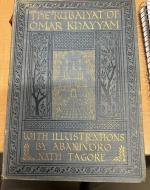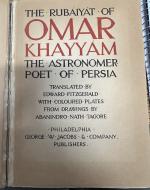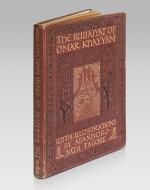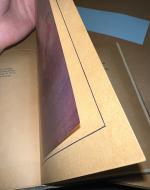Created by Nino Paoli on Tue, 05/23/2023 - 02:51
Description:
This version of The Rubáiyát of Omar Khayyám, The Astronomer Poet of Persia, translated by Edward Fitzgerald, and with illustrations by Abanindro Nath Tagore (also known as “Abanindranath”), was published in 190- by George W. Jacobs & Company, as seen in the title page of the edition (see Figure 1). Going back as far as publishing Perrault's Fairy Tales in the late 1600s, George W. Jacobs & Co. was an American publisher based out of Philadelphia (OpenLibrary.org).
This version of the Rubáiyát was also printed by other publishers, one being The Bodley Head, which is a publisher in London, England (“Osian’s”). However, this edition was not mass-produced, as its woven cloth cover is too intricate (see Figure 2).
There is another version of this edition that came out of George W. Jacobs & Co., though: a fire-red woven cover with the same gilded text as this edition, but with black flowers and trees ornating the cover, instead (see Figure 3) (Saffronart).
The “illustrations” appear to be “individually tipped-in on thick card sheets within frames;” the term “tipped-in” meaning that the colored plates (cards) with illustrations on them were printed separately from the main text of this edition of the Rubáiyát, and then attached to the book (see Figure 4) (“Glossary”).
Author Debashish Banerji suggests the illustrated plates by Tagore reflect the influence of the “Pan-Asianist philosophy of spiritual transcendence,” as Tagore fuses Japanese and Indian painting styles to create the beautiful – and, arguably, orientalist – works of art (Romain).
The Japanese technique of wash – where a fine layer of color is spread with a brush over a broad surface evenly, so that no brush marks are visible – which is used in Tagore’s illustrations in this edition of the Rubáiyát, reflect his time studying under Japenese artist Taikoan and Hilsida (Museum).
Writer Shantanu Ray Chaudhuri says that Tagore is “a master storyteller," and "often reinterpreted literary sources, overhauling the written word to a visual language, for his imageries and even paint entire series of works,” pointing to the Rubáiyát as a literary source where Tagore painted a series for (Ray Chaudhuri). This may be why – as discussed in my close reading and analysis of one of Tagore’s paintings paired with a quatrain – the paintings deviate from or add onto the preexisting text.
Works Cited:
“Abanindranath Tagore (1871 - 1951).” Bid and Hammer, auctions.bidandhammer.com/rubaiyat-of-omar-khayyam. Accessed 22 May 2023.
“Glossary of Book Terms.” AbeBooks, 25 Jan. 2023, www.abebooks.com/books/rarebooks/collecting-guide/understanding-rare-boo....
Museum, Victoria and Albert. “Print: Tagore, Abanindranath: V&A Explore the Collections.” Victoria and Albert Museum: Explore the Collections, 22 Jan. 2009, collections.vam.ac.uk/item/O184439/print-tagore-abanindranath/.
OpenLibrary.org. “George W. Jacobs & Co.. Publisher - 57 Works / 27 Ebooks.” The Internet Archive’s Open Library: One Page for Every Book, openlibrary.org/publishers/George_W._Jacobs_&_Co. Accessed 22 May 2023.
Osian’s Auction Catalogue the ABC Series | July 2008, assets.osianama.com/ecatalogue/2008-07-15-The-ABC-Series/. Accessed 22 May 2023.
Ray Chaudhuri, Shantanu. “Abanindranath Tagore: The Enigmatic Original Who Wrote Art and Painted Words.” The Daily Eye, 31 Jan. 2022, thedailyeye.info/thought-box/abanindranath-tagore-the-enigmatic-original-who-wrote-art-and-painted-words/18b7939d37a640ec.
Romain, Julie. The Alternate Nation of Abanindranath Tagore, 29 June 2011, caareviews.org/reviews/1661.
Saffronart. “The Rubaiyat of Omar Khayyam.” StoryLTD, www.storyltd.com/auction/item.aspx?eid=3690&lotno=78. Accessed 22 May 2023.
“Wash Drawing.” Encyclopædia Britannica, www.britannica.com/art/wash-drawing. Accessed 22 May 2023.
Copyright:
Associated Place(s)
Artist:
- Abanindro Nath Tagore





